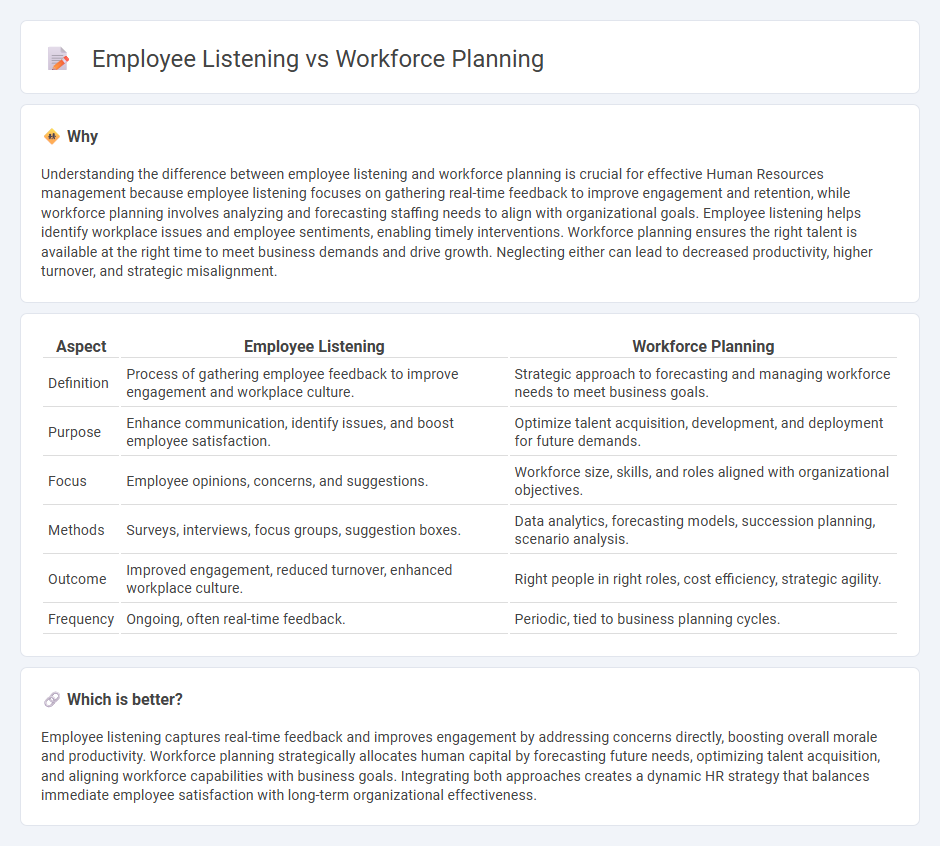
Employee listening gathers real-time feedback to understand workforce sentiment, driving engagement and retention strategies. Workforce planning analyzes staffing needs and skill gaps to align human capital with organizational goals, ensuring optimal productivity. Explore how integrating employee listening with workforce planning transforms talent management effectiveness.
Why it is important
Understanding the difference between employee listening and workforce planning is crucial for effective Human Resources management because employee listening focuses on gathering real-time feedback to improve engagement and retention, while workforce planning involves analyzing and forecasting staffing needs to align with organizational goals. Employee listening helps identify workplace issues and employee sentiments, enabling timely interventions. Workforce planning ensures the right talent is available at the right time to meet business demands and drive growth. Neglecting either can lead to decreased productivity, higher turnover, and strategic misalignment.
Comparison Table
| Aspect | Employee Listening | Workforce Planning |
|---|---|---|
| Definition | Process of gathering employee feedback to improve engagement and workplace culture. | Strategic approach to forecasting and managing workforce needs to meet business goals. |
| Purpose | Enhance communication, identify issues, and boost employee satisfaction. | Optimize talent acquisition, development, and deployment for future demands. |
| Focus | Employee opinions, concerns, and suggestions. | Workforce size, skills, and roles aligned with organizational objectives. |
| Methods | Surveys, interviews, focus groups, suggestion boxes. | Data analytics, forecasting models, succession planning, scenario analysis. |
| Outcome | Improved engagement, reduced turnover, enhanced workplace culture. | Right people in right roles, cost efficiency, strategic agility. |
| Frequency | Ongoing, often real-time feedback. | Periodic, tied to business planning cycles. |
Which is better?
Employee listening captures real-time feedback and improves engagement by addressing concerns directly, boosting overall morale and productivity. Workforce planning strategically allocates human capital by forecasting future needs, optimizing talent acquisition, and aligning workforce capabilities with business goals. Integrating both approaches creates a dynamic HR strategy that balances immediate employee satisfaction with long-term organizational effectiveness.
Connection
Employee listening provides critical insights into workforce needs, preferences, and challenges, enabling more accurate workforce planning. By analyzing feedback collected through surveys, focus groups, and performance reviews, HR professionals can identify skills gaps, anticipate turnover, and align talent acquisition strategies accordingly. This data-driven approach enhances workforce planning effectiveness and supports employee engagement and retention.
Key Terms
**Workforce Planning:**
Workforce planning strategically analyzes labor market trends, organizational goals, and skill gaps to ensure the right talent is available at the right time. It encompasses demand forecasting, supply analysis, and talent management aligned with business objectives to optimize productivity and reduce turnover costs. Discover how effective workforce planning drives competitive advantage and operational excellence.
Succession Planning
Succession planning requires a strategic workforce planning approach that identifies future leadership gaps and develops internal talent pipelines to ensure organizational stability. Employee listening plays a crucial role by capturing real-time feedback and employee aspirations, which helps tailor development programs and improve retention rates. Explore how combining workforce planning with employee listening enhances your succession strategy for sustained growth.
Talent Gap Analysis
Workforce planning strategically identifies current and future talent gaps by analyzing skill shortages and workforce demands to align organizational goals. Employee listening gathers real-time feedback to uncover hidden challenges and employee sentiments that impact talent retention and development. Discover how integrating these approaches enhances Talent Gap Analysis for comprehensive workforce optimization.
Source and External Links
What Is Workforce Planning? Strategies and Benefits - Paychex - This webpage provides an overview of workforce planning, discussing its process, strategies, and benefits for organizations.
Workforce Planning: Definition, Process and Principles - Indeed offers guidance on workforce planning, including its definition, process steps, and key principles for successful implementation.
A Guide to Workforce Planning: Process, Strategies, & Template - This article provides a comprehensive guide to workforce planning, covering its process, strategies, and the importance of using talent management solutions.
 dowidth.com
dowidth.com